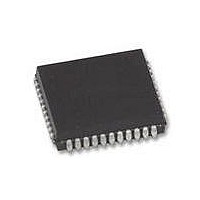XR88C681J-F Exar Corporation, XR88C681J-F Datasheet - Page 79

XR88C681J-F
Manufacturer Part Number
XR88C681J-F
Description
IC UART CMOS DUAL 44PLCC
Manufacturer
Exar Corporation
Type
CMOS Dual Channel UARTr
Datasheet
1.XR88C681CP40-F.pdf
(101 pages)
Specifications of XR88C681J-F
Number Of Channels
2, DUART
Package / Case
44-LCC (J-Lead)
Features
*
Fifo's
1 Byte, 3 Byte
Voltage - Supply
5V
With Parallel Port
Yes
With Cmos
Yes
Mounting Type
Surface Mount
Data Rate
1 Mbps
Supply Voltage (max)
5.25 V
Supply Voltage (min)
4.75 V
Supply Current
15 mA
Maximum Operating Temperature
+ 85 C
Minimum Operating Temperature
- 40 C
Mounting Style
SMD/SMT
Operating Supply Voltage
5 V
Propagation Delay Time Ns
400 ns
No. Of Channels
2
Supply Voltage Range
4.75V To 5.25V
Operating Temperature Range
-40°C To +85°C
Digital Ic Case Style
PLCC
No. Of Pins
44
Filter Terminals
SMD
Rohs Compliant
Yes
Lead Free Status / RoHS Status
Lead free / RoHS Compliant
Lead Free Status / RoHS Status
Lead free / RoHS Compliant, Lead free / RoHS Compliant
Other names
1016-1329
Available stocks
Company
Part Number
Manufacturer
Quantity
Price
Company:
Part Number:
XR88C681J-F
Manufacturer:
Exar Corporation
Quantity:
10 000
H. SPECIAL MODES OF OPERATION
H.1 RTS/CTS Handshaking
The DUART can be programmed to support RTS/CTS
Handshaking, as a means of data flow control with other
devices. This section will describe a couple of options that
the DUART allows the user in implementing RTS/CTS
Handshaking. Specifically, these options are:
D Receiver-Controlled RTS/CTS Handshaking
D Transmitter-Controlled RTS/CTS Handshaking
Rev. 2.11
FFULLA
RXDA
RTSA
Figure 42. Block Diagram and Timing Sequence of Two DUARTs Connected
Receiving Device
To CPU
FFULLA
(OP4)
in the Receiver-RTS Controlled Configuration
RTSA
RXDA
CTSA
(OP0)
TXDA
(IP0)
79
H.1.1 Receiver-Controlled RTS/CTS Handshaking
In this mode, the Receiver has the ability to automatically
negate the RTS output (to the Transmitting device).
Specifically, this mode allows the Receiver to negate the
RTS signal if its RHR is full; and, is thereby, very effective
in preventing Receiver Overrun Errors.
presents a diagram of an example illustrating the
operation of the Receiver-Controlled RTS configuration.
CTSB
(IP1)
TXDB
RXDB
RTSB
(OP1)
Transmitting Device
XR88C681
Figure 42












